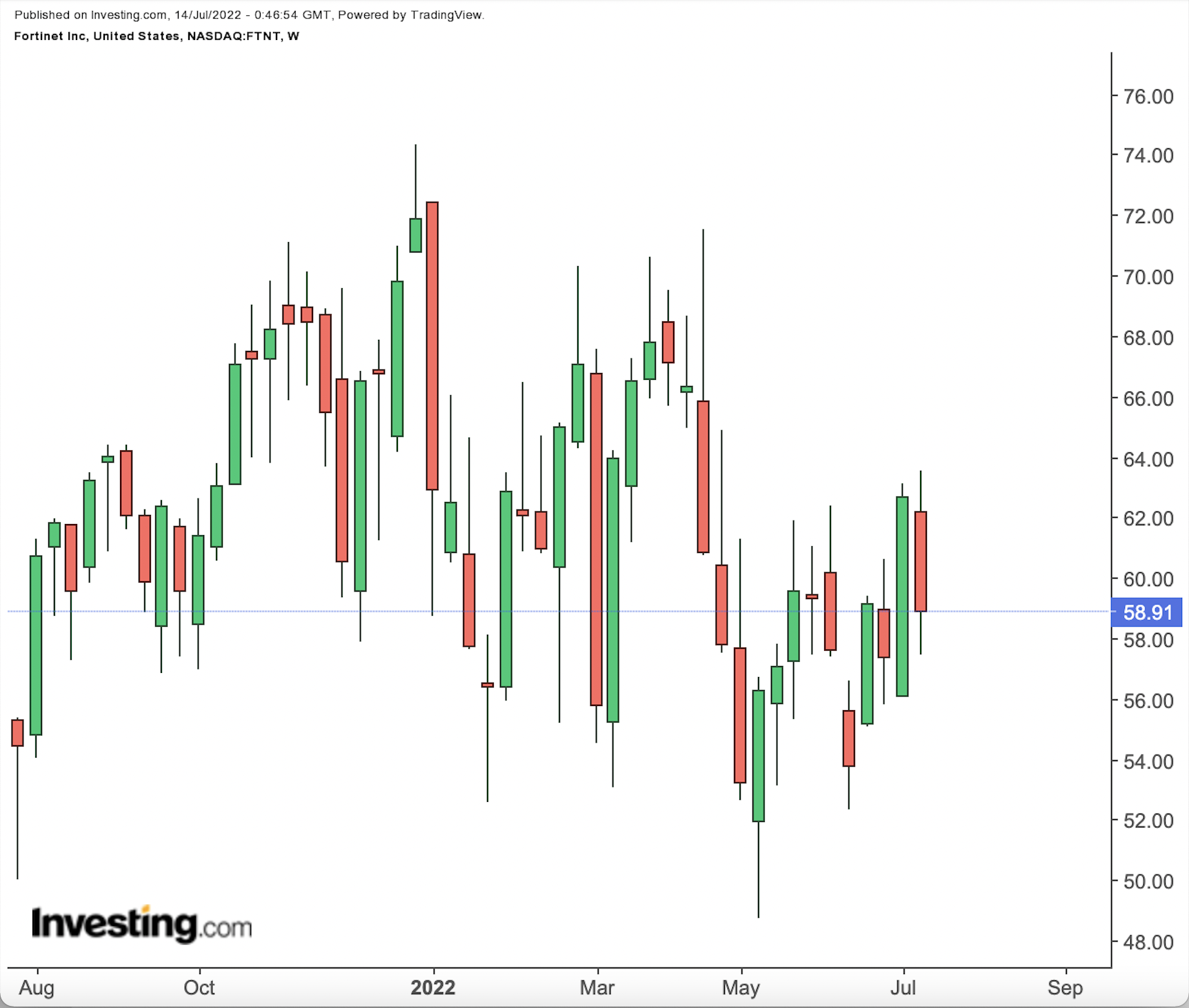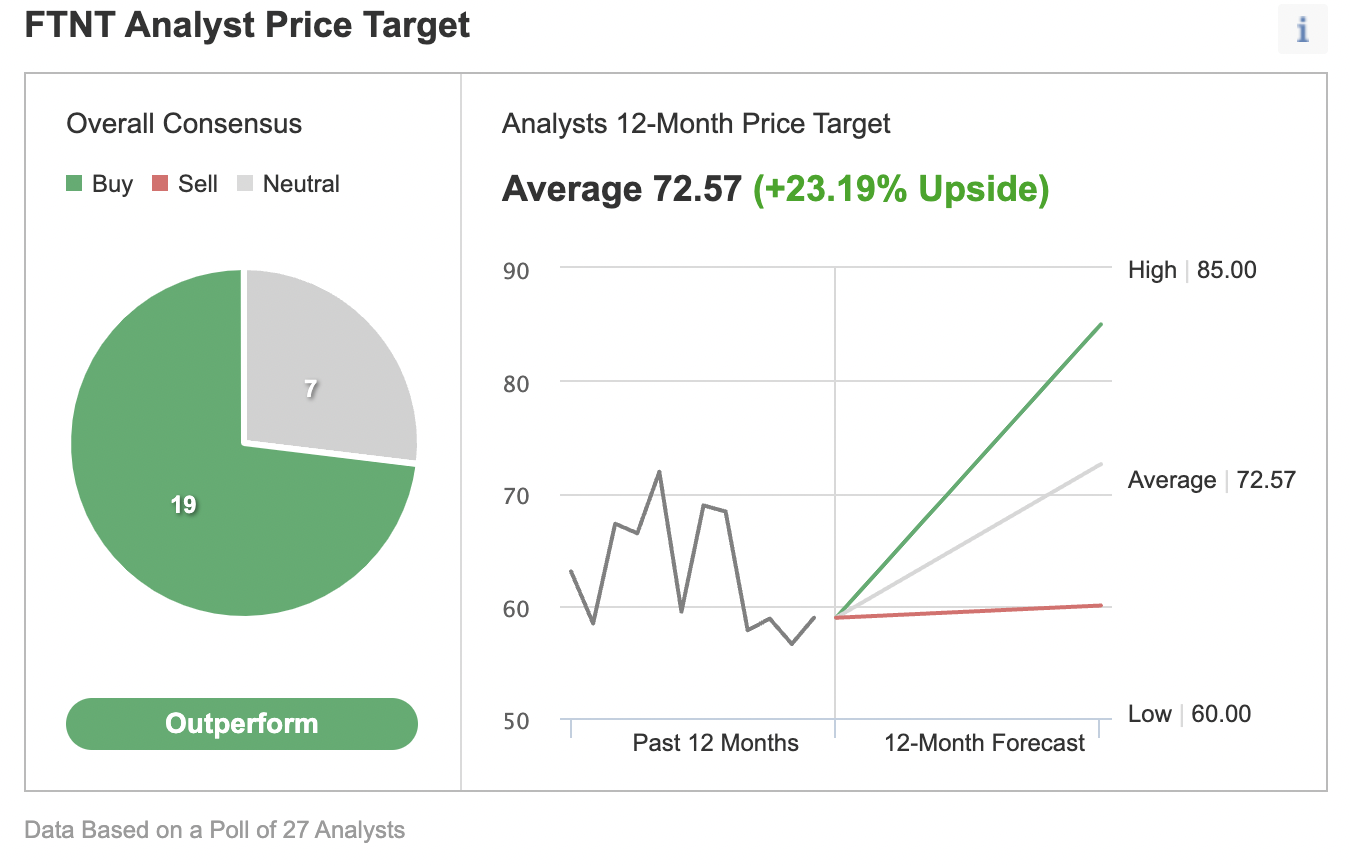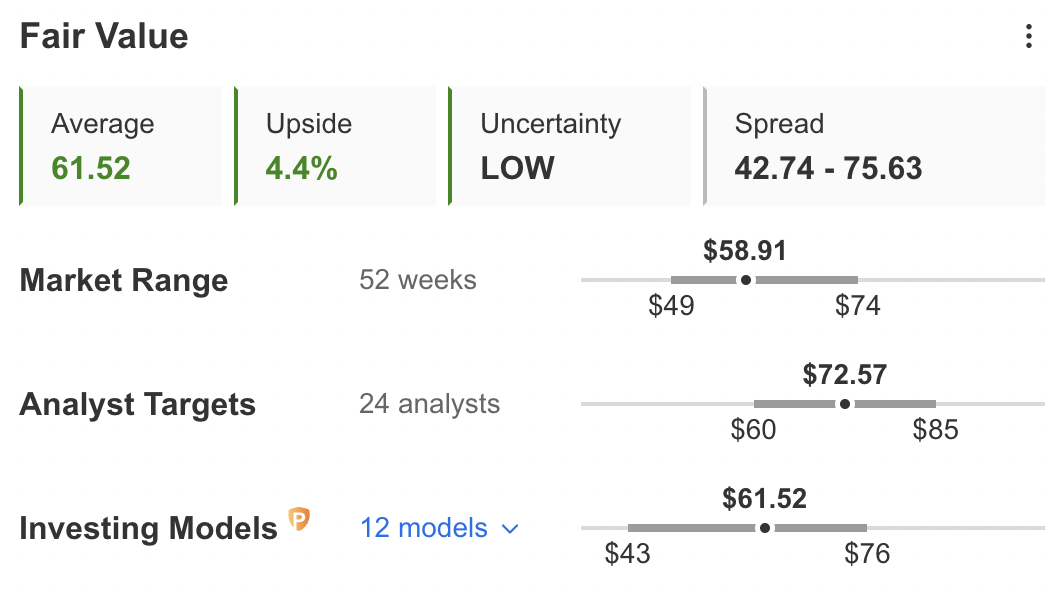- Shares of cybersecurity firm Fortinet are down 18% since the start of 2022
- FTNT had a 5-to-1 stock split in late June
- Long-term investors whose portfolios allow for short-term volatility could consider buying Fortinet stock ahead of the earnings release
Cybersecurity company Fortinet (NASDAQ:FTNT) offers integrated network security solutions, with a market share of well over 40% of the threat intelligence market.
Among its thousands of clients are Alaska Air Group (NYSE:ALK), International Business Machines (NYSE:IBM), the U.S. Department of Defense, Walmart (NYSE:WMT), and the UK-based BT Group (LON:BT). As a result of the rise of cloud computing, Fortinet and its peers are benefiting from an upgrade cycle in data centers.
Shareholders in FTNT have seen the value of their investment appreciate 14.5% over the past 52 weeks. However, the stock has declined 18% year-to-date (YTD). By comparison, the S&P Kensho Cyber Security Index has lost 19.1% so far in 2022. Meanwhile, shares of cybersecurity rivals, like Palo Alto Networks (NASDAQ:PANW) and VMware (NYSE:VMW) have lost 11.3% and 5.1% YTD.

On Dec. 29, FTNT shares hit a record high. However, shares plunged to a 52-week low in early May. The stock’s 52-week range has been $48.73 - $74.35. We should remind readers that Fortinet completed 5-for-1 stock split in June.
Recent metrics suggest:
“The global cyber security market size is projected to reach US$376.32 billion by 2029, from US$139.77 billion in 2021.”
With a market capitalization of $47.9 billion, FTNT stock is likely to participate in that growth.
Recent Metrics
The company released Q1 figures on May 4. Revenue totaled $954.8 million, up 34.4% year-over-year. Adjusted diluted earnings per share (EPS) came in at 94 cents, up from 81 cents in the same quarter the year before. The company generated free cash flow of $273.5 million. Cash and equivalents ended the period at $973.5 million.
On the results, CEO Ken Xie commented:
“We delivered better than expected first quarter revenue growth of 34% year over year, driven by record quarterly product revenue growth of 54% year over year… At the same time, we improved visibility to our future business by increasing backlog by $116 million in the first quarter.”
The company anticipates second quarter revenue to come in the range of $1.005-$1.035 billion. Fortinet is set to release its Q2 results on Aug. 3.
Prior to the release of the Q1 results, FTNT stock was changing hands around $57. At the time of writing, it is at $59.40.
What To Expect From Fortinet Stock
Among 27 analysts polled via Investing.com, FTNT stock has an "outperform" rating.

Source: Investing.com
Wall Street has a 12-month median price target of $72.57 for the stock, implying an increase of over 23% from the current price. The 12-month price range currently stands between $60 and $85.
However, according to several valuation models, like those that might consider P/E or P/S multiples or terminal values, the average fair value for FTNT stock on InvestingPro stands at $61.52, implying a 4.4% upside potential.

Source: InvestingPro
We can also look at FTNT’s financial health as determined by ranking more than 100 factors against peers in the information technology sector. For instance, in terms of growth, profit, and price momentum, it scores 4 out of 5. Its overall score of 4 points is a great performance ranking.
Our expectation is for FTNT stock to trade in a range and build a base between $52 and $67 in the coming weeks. Afterwards, shares could potentially start a new leg up.
Adding FTNT Stock To Portfolios
Fortinet bulls who are not concerned about short-term volatility could consider investing now. Their target price would be $72.57, as per the long-term target provided by analysts.
Alternatively, investors could consider buying an exchange-traded fund (ETF) that has FTNT stock as a holding. Examples include:
- Global X Cybersecurity ETF (NASDAQ:BUG)
- Invesco Dynamic Networking ETF (NYSE:PXQ)
- Franklin Exponential Data ETF (NYSE:XDAT)
- iShares Cybersecurity and Tech ETF (NYSE:IHAK)
Finally, those who are experienced with options could also consider selling a cash-secured put option in FTNT stock—a strategy we regularly cover. Such a bullish trade could especially appeal to those who want to receive premiums (from put selling) or to possibly own FTNT shares for less than their current market price of $59.40.
Most option strategies are not suitable for all retail investors. Therefore, the following discussion on FTNT stock is offered for educational purposes and not as an actual strategy to be followed by the average retail investor.
Cash-Secured Puts On FTNT
Price At Writing: $59.40
Let's assume an investor wants to buy FTNT stock but does not want to pay the full price of $59.40 per share. Instead, the investor would prefer to buy the shares at a discount within the next several months.
One possibility would be to wait for FTNT stock to fall further, which it might or might not do. The other possibility is to sell one contract of a cash-secured FTNT put option.
So the trader would typically write an at-the-money (ATM) or an out-of-the-money (OTM) put option and simultaneously set aside enough cash to buy 100 shares of the stock.
Let's assume the trader is putting in this trade until the option expiry date of Sept. 16. As the stock is $59.40 at time of writing, an OTM put option would have a strike of $55.
The FTNT Sept. 16 55-strike put option is currently offered at a price (or premium) of $3.05.
An option buyer would have to pay $3.05 X 100, or $305, in premium to the option seller. This premium amount belongs to the option seller no matter what happens in the future and also it is the seller’s maximum gain. The put option will stop trading on Friday, Sept. 16.
If the put option is in the money (meaning the market price of FTNT stock is lower than the strike price of $50) any time before or at expiration on Sept. 16, this put option can be assigned. The seller would then be obligated to buy 100 shares of FTNT stock at the put option's strike price of $55 (i.e. at a total of $5,500).
The break-even point for our example is the strike price ($55) less the option premium received ($3.05), i.e., $51.95. This is the price at which the seller would start to incur a loss.
Bottom Line
Cash-secured put selling is a moderately more conservative strategy than buying shares of Fortinet outright at the current market price. This can be a way to capitalize on the choppiness in FTNT stock in the coming weeks, especially around the earnings release.
Investors who end up owning FTNT shares as a result of selling puts could further consider setting up covered calls to increase the potential returns on their shares. Thus, selling cash-secured puts could be regarded as the first step in stock ownership.
Disclosure: Tezcan Gecgil, PhD, does not have any positions in the securities mentioned in this article.
